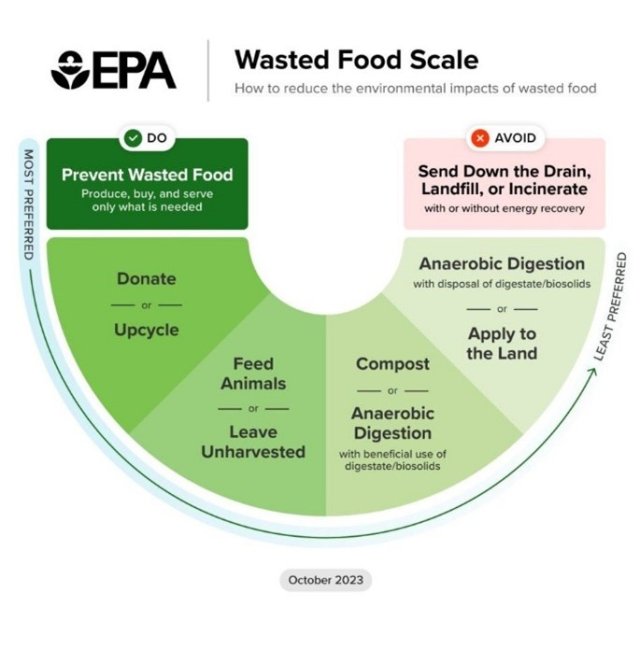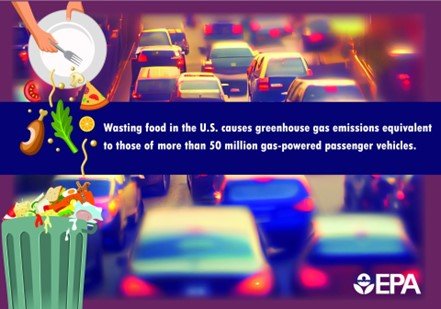Newswise — The U.S. Department of Agriculture estimates that over one-third of the food produced in the United States is never eaten, wasting the resources used to produce, transport, process, and distribute it – and much of it is sent to landfills, where it breaks down and generates methane, a powerful greenhouse gas.
EPA researchers released two new reports to provide more details about the story of food waste in the United States. “From Field to Bin: The Environmental Impacts of U.S. Food Waste Management Pathways” provides updated recommendations for managing food waste, including the new Wasted Food Scale. It accompanies the 2021 report, “From Farm to Kitchen: The Environmental Impacts of U.S. Food Waste.” The second report, “Quantifying Methane Emissions from Landfilled Food Waste,” describes the impacts of food waste on U.S. landfill methane emissions.
A webinar with the researchers will be held on January 17, 2024 at 3:00pm. Register here.
From Field to Bin: The Environmental Impacts of U.S. Food Waste Management Pathways
This report updates the recommendations for the preferred methods of food waste disposal and management for the first time since the 1990s.These recommendations replace EPA’s former “Food Recovery Hierarchy” with the new “Wasted Food Scale.” This report follows the 2021 report, “From Farm to Kitchen: The Environmental Impacts of U.S. Food Waste,” which illustrates how food is wasted in the production process, including from growing the food to transporting it to the stores or restaurants where we get our food.


The new “From Field to Bin: The Environmental Impacts of U.S. Food Waste Management Pathways” report begins when food is wasted and follows the different management pathways for the food that we do not consume. It is a comparative look at the possible actions we can take to manage or dispose of our uneaten food and what each action’s relative impact is.
The report investigates eleven pathways for wasted food: source reduction; donation; upcycling (i.e., repurposing wasted food into new food for human consumption); animal feed; anaerobic digestion; composting; controlled combustion (i.e., incineration); land application (i.e., applying raw wasted food to soil); landfilling; sewer/wastewater treatment (i.e., sending wasted food “down the drain”); and unharvested/plowed in (i.e., leaving crops in the field).
A major conclusion from the report shows that preventing wasted food altogether is the most preferred action to reduce the environmental impact of food waste, while sending wasted food to the landfill, down our sink drains, or to the incinerator are the least preferred actions.
“Even spending a little time to prevent food waste, such as only buying what you need, is more important than spending a lot of time making a choice between one of the other pathways,” Shannon Kenny, the lead author on the “Farm to Kitchen” and “Field to Bin” reports, said. “Even the best management pathways can’t make up for the resources used to produce the food.”
The research employs two methodologies to assess the pathways: Life Cycle Assessment and Circularity Assessment. A review of approximately 250 life cycle analyses helped to determine the life cycle environmental impacts of each pathway, and researchers performed a qualitative assessment of each pathway’s contribution to a circular economy, focusing on the environmental aspects of circularity. A circular economy keeps materials and products in circulation for as long possible. This reduces material use, redesigns materials to be less resource intensive, and recaptures “waste” as a resource to manufacture new materials and products. Kenny particularly enjoyed writing the Circularity Assessment section of the report because of her interest in circular economies and because of the assessment’s novelty for the field.
“I hope this report excites people about the value of food,” Kenny said. “Food prices have gone up over time and prevention can save consumers money in addition to saving the environmental impacts.”
Quantifying Methane Emissions from U.S. Landfills

Methane, a powerful greenhouse gas, is emitted from landfills when organic waste decays over time under anaerobic conditions. Municipal solid waste landfills are the third largest source of methane emissions from human activities in the United States. Food waste comprises about 24 percent of municipal solid waste in landfills. Due to its quick decay rate, food waste in landfills contributes to more methane emissions than any other landfilled materials. An estimated 58 percent of the fugitive methane emissions (those released to the atmosphere) from municipal solid waste landfills are from landfilled food waste.
“Based on our modeling, food waste has an outsized role in landfill methane emissions,” EPA researcher Dr. Max Krause, the lead author on the report, said.
The report is the first of its kind to quantify the best estimate of how much methane is emitted from landfilled food waste. Many models and tools have similar data about emissions embedded in them, but methane emissions have not been explicitly quantified by this categorization before.
The report was a natural extension of Krause’s experiences and interests. When he was in graduate school, Krause spent time on-site at a landfill to learn about how landfill systems are engineered and how the spaces operate. His dissertation was also on landfill methane gas modeling.
Explaining compelling information to the public about landfilled food waste’s large role in methane emissions was one of the catalysts to produce the report, especially given the rising global interest in food waste prevention and methane mitigation programs. Krause and Kenny explained that food waste has faster decay rates than other organic materials, such as paper or wood. This concept is well-known in solid waste and scientific communities but may not be emphasized in public conversations about food waste.
“This report can help people understand how food waste in landfills contributes to climate change and may help people focus their efforts on reducing the amount of food that goes to landfills,” Kenny said. “Reducing food waste will reduce landfill methane.”
This body of research provides a better understanding of the net environmental impact of U.S. food waste and will support future EPA efforts to reduce food waste.
Looking forward, EPA researchers will present these findings during a free, public webinar January 17 at 3pm ET. Register to attend the webinar below.
Researchers used a few primary EPA tools and datasets to produce this report:
- Landfill Gas Emissions Model (LandGEM) is an Excel-based tool used to estimate emission rates for total landfill gas, methane, carbon dioxide, non-methane organic compounds, and individual air pollutants from municipal solid waste landfills.
- Waste Reduction Model (WARM) provides total lifecycle GHG emissions estimates from different waste management practices, including landfilling, based on lifecycle assessment data.
- Inventory of U.S. Greenhouse Gas (GHG) Emissions and Sinks tracks GHG emissions and sinks by source, economic sector, and greenhouse gas, from 1990 to present, and releases a report each year.
- Landfill and Landfill Gas Energy Database (LMOP Database) tracks key data for MSW landfills in the United States, including information about landfill gas energy projects.
Read more:
Register for the January Tools & Resources Webinar on Food Waste Reports
EPA Releases New Food Waste Reports: Press Release
From Field to Bin: The Environmental Impacts of U.S. Food Waste Management Pathways
From Farm to Kitchen: The Environmental Impacts of U.S. Food Waste
Quantifying Methane Emissions from Landfilled Food Waste
Learn more about EPA's food waste research
Learn more about the sustainable management of food
U.S. Methane Emissions Reduction Action Plan, The White House Office of Domestic Climate Policy (pdf)
This article was written by EPA’s Caroline Cole

